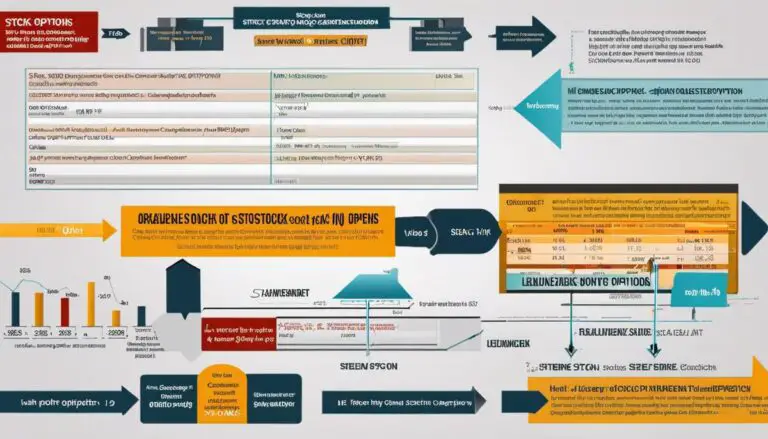The world of Stock Market Investment offers opportunities for substantial financial gains, but understanding its complexity is essential before diving in. An overall grasp of numerous factors from stock market mechanics, the art of selecting promising stocks, risk management strategies, timing the market to leveraging technology significantly impact one’s success in this realm. It is imperative for potential investors to accrue the prerequisite knowledge prior to testing the waters in this vast fiscal ocean. This awareness goes a long way in achieving financial objectives and reaping rich rewards from stock market investments.
Understanding Stock Market Mechanics
Principles and Elements: The Driving Forces Behind The Stock Market
Harnessing the tempestuous winds of the stock market can appear a daunting task at first glance. It operates on intricate mechanisms and fluctuating waves of change. However, there are several key principles and underlying elements that drive this complex entity. Understanding these offers the entrepreneurial mind a toolset for navigating the ever-changing tides of the stock market.
First and foremost, the stock market is far from a static structure. Instead, it ebbs and flows based on the collective behavior of investors. It’s subsequently influenced by a broad spectrum of factors ranging from economic indicators to market sentiment, industry developments to global geopolitics, and beyond. Decoding this mosaic of motives requires an acute understanding of economics, psychology, and even sociology.
The principle of supply and demand sits at the heart of the stock market. This primary economic theory stipulates that the price of a stock rises when demand outweighs supply and falls when supply exceeds demand. Thus, the purest way to understand changes in a stock’s price is to study the push and pull of supply and demand, often a result of investor sentiment and company performance.
Another foundational element at play in the stock market is the anticipated earnings of a company. They play a significant role in shaping investors’ perceptions and consequently, the stock prices. If a company displays a strong track record of profitability, it’s bound to attract more investors. It is, however, essential to be cognizant of market expectations. The stock price can tumble even with strong earnings if they fail to meet or exceed these market expectations.
Inextricably linked to the anticipated earnings is the element of interest rates. Lower interest rates generally induce higher investment in stocks as borrowing costs are cheaper, ultimately driving up stock prices. Conversely, rising interest rates can dampen investor enthusiasm, thus creating downward pressure on stock prices.
Lastly, the prevailing geopolitical climate propels the stock market’s tumultuous waves. Be it trade wars, elections, disruptions in oil-producing countries, they all reverberate on the market floor. Investors must always be cognizant of the broader geopolitical landscape, with an emphasis on the markets and industries their stock portfolio is concentrated in.
While these principles and elements provide a cornerstone to understand the stock market, it’s of paramount importance to remember the inherent risks and unpredictable nature of the stock market. A seasoned entrepreneur understands that while norms and patterns offer a guide, there is no substitute for continuous market scrutiny, placing equal emphasis on ongoing education and staying attuned to economic trends and industry shifts.

Choosing the Right Stocks: Analysis & Research
Understanding the art and science of stock market investment necessitates the deployment of strategic analytical tools and methods. The intelligent entrepreneur must consider multiple facets to better select prospective stocks — relying on sector analysis, utilization of key financial ratios and technical analysis, incorporation of artificial intelligence (AI), and a commitment to lifelong learning.
Sector analysis largely focuses on dissecting each industry within the economy. Today’s savvy entrepreneur is aware that different sectors typically trade in cycles. Proactively evaluating the phase and potential of each industry—from biotech and tech, healthcare, to manufacturing, energy, or financial—gives the investor an upper hand in stock picking while mitigating the risks associated with sticking strictly to one sector.
Incorporating key financial ratios is another fundamental strategy. Smart businesspeople review and interpret Price Earnings (PE) ratio, Debt-Equity ratio, Return on Equity (ROE), among others. These financial indicators might seem banal to the uninitiated, but for the astute investor, they give invaluable insights into a company’s financial health, growth prospects, and market position. A study of these ratios must be made not in isolation but in tandem with sector peers and historical data.
The world of investing has also been revolutionized by technology, and one of the most compelling advancements lighting the way for investors is artificial intelligence (AI). Leveraging machine learning algorithms and data mining processes, AI can pilot predictive modeling to forecast trends, flagging potential red flags or highlighting potential investment opportunities much faster than traditional human initiatives could ever achieve. The technology can sift through complex financial data quickly, providing in-depth company and market analysis.
Finally, it must be noted that in this rapidly evolving global economy, lifelong learning isn’t an option—it’s a requirement. Even the most successful investors, with their immense knowledge and extensive professional networks, invest their time to continuously learn and understand new strategies, market trends, financial tools, and relevant technological advancements that could reshape the business landscape. Regularly reading, attending workshops, seminars, and engaging with thought leaders globally can provide fresh perspectives, industry insights, and even investment ideas.
In conclusion, the journey to make powerful and insightful investments in promising stocks requires a blend of strategic sector analysis, evaluation of financial ratios, use of technological advancements such as AI, and an irrevocable commitment to continuous learning. However, remember that regardless of the tools and strategies employed, investing in the stock market comes with inherent risks and should be managed wisely.

Photo by austindistel on Unsplash
Portfolio Diversification: Risk Management Strategy
As we explore the vast landscape of potential financial gains through the stock market, one must recognize the critical importance of portfolio diversification. This strategy provides a safety net to protect investors against the volatility and uncertainty inherent in the stock exchange. The savvy investor doesn’t merely play the game; they change the game through a potent mix of prudent judgments and strategic risk-taking, displaying a mastery of calculated diversification.
Picture this: equities behave much like the ocean. Smooth sailing one day can turn into rough seas the next. Now, imagine you have several boats in the water. If the storm hits, would it be better to anchor all your boats in one place, or to spread them throughout different regions of the water? The answer within the world of investing is resoundingly clear: diversification ensures the potential to ride out any storm.
Diversification is no random guessing game; it is a meticulously deployed tool utilized by the finest in their field. It instills a balance of different types of investments that potentially react differently to the same economic event. By diversifying the investments in your portfolio, you can increase your profitability due to the varying performance of different security types, industries, and countries.
But what does this optimal diversification look like?
Simply put, it’s diversification beyond equities. A well-rounded portfolio dips into bonds, real estate, commodities, and even cryptocurrencies. By investing in a variety of markets, economic downturns impacting one sector may not derail the overall portfolio performance. It’s essential to view this axiom through a wider lens, though.
Furthermore, geographical diversification can also reap excellent benefits. Investing in international markets could provide insulation against domestic downturns. Embracing an international perspective is the difference between good investors and great ones.
Investors need to diversify across industries. No single sector is immune to downturns. Consider technology, healthcare, finance, or consumer goods. By spreading investment across various sectors, the negative performance from a specific sector can be counterbalanced by the positive performance of others.
However, effective diversification goes beyond simply adding a mix of assets; it’s about understanding the correlation between investments. Assets that are positively correlated will move in the same direction; when one rises, so does the other, and vice versa. By adding assets with negative correlation into the mix, the portfolio gains an additional buffer as these negatively correlated investments likely move in opposite directions.
Last but not least, time is an essential aspect of diversification. Consider the power of long-term growth securities – stocks and bonds that may provide continuous returns over a long span, while more short-term tactical investments can take advantage of immediate trends.
In conclusion, diversification isn’t a bulwark against all risks, but it can ensure your portfolio isn’t completely sunk by one devastating storm. While the need for diversification is a universally accepted investing axiom, the geeky enthusiasm for the subtleties of its application distinguishes true economic maestros from the market rookies. So, master the art of diversification, and level-up on your wealth creation game.

Timing the Market and Making Profits
When an entrepreneur immerses themselves into the stock market, it becomes clear that success is not simply about stock selection or investment strategy—it’s also about timing. The concept of timing the market centers on striving to predict future market movements to buy low and sell high. This action involves operating strategies that, when executed correctly, either under a fortuitous star or an exceptional understanding of the market trends, can catapult profits.
However, it’s critical not to underestimate the complexity of this gambit. It’s not as simple as it appears to buy at the mere hint of an uptrend and sell on suspicion of a retreat. The stock market is an aggregation of countless transactions dictated by emotional decisions from investors around the world, hence, it’s fickle and unpredictable.
It’s well-documented among finance professionals that even the seasoned investor may struggle to time the market consistently. A powerfully cogent illustration of the challenge—and unpredictability—of timing the market is the dot-com bust of the early 2000s and the financial crisis in 2008. Many esteemed investors were unable to predict these recessions, leading to substantial financial losses.
Research also supports this perspective. According to a study by Dalbar, a Boston-based firm specializing in financial services, in the 20-year period ending December 31, 2018, the S&P 500 yielded an average of 7.8% annually whilst the average investor earned only 4.1%. The discrepancy is linked to the attempt to time the market, incurring costs and taxes, and inevitably misjudging market movements.
Meanwhile, contrasting voices advocate for strategic timing in a less conventional sense—investing consistently over time. Known as dollar-cost averaging, this involves allocating a fixed amount into a particular investment on a regular schedule, regardless of its price. Purchasing more when prices are low and less when prices are high gradually leads to a lower average cost per share, potentially boosting profits in the long run.
In the chess-like game of investing, entrepreneurs would do well to pair this with consistent vigilance. Behind the world’s most successful investors is a commitment to monitoring market trends, seizing opportunity when others see chaos, and acute patience, courageously sitting out turbulence.
A strategic entrepreneur understands that timing the market is an audacious challenge that can sometimes resemble Russian roulette. But a prudent, well-planned approach can go a long way in protecting one’s investments and even offering a potential leg up in return. In other words, the entrepreneur is not trying to outwit the market – they’re using time as an ally to manage risk and potentially enhance returns.
Timing the market is a high stakes gamble—a strategy not for the faint-hearted. Yet, those with vigorous mastery of the game, armed with extensive knowledge, and superior risk tolerance, may leverage it for substantial gains. Remember the words of the great Benjamin Graham, “The stock investor is neither right or wrong because others agreed or disagreed with him; he is right because his facts and analysis are right.” Therefore, success in timing the market largely depends on precision, intelligence, and a touch of audacious fortitude.

Leveraging Technology for Stock Investment
Taking the bull by the horns, identifying opportunities in the stock market using cutting-edge technology isn’t merely a goal, it’s a threshold.
The evolution of technology is transforming not just the way stock investing is carried out, but also reforming how investors perceive the market.
The potential that modern technology exhibits in stock investments is expansive and innovative, ranging from big data analytics to robo-advisory services, algorithmic trading, and blockchain technology.
Big data analytics is a vital tool for today’s savvy investor.
It presents an extensive analysis of voluminous data, offering insights and trends that may otherwise be overlooked.
This allows investors to make informed decisions, bringing science-based certitude to the otherwise nebulous world of investment strategy.
Investor analytics using cloud computing technologies also enable investors to analyze market movements promptly, leading to quicker and more accurate decision-making processes.
Robo-advisory services have emerged as a potent tool in the stock investing arena.
These automated digital platforms provide investors with financial advice or portfolio management online with minimal human intervention.
They help in tailoring a portfolio that matches customers’ risk appetite, financial goals, and investment horizon- all done algorithmically without human bias.
Algorithmic trading is another innovation that is making waves in the world of stock investments.
This sophisticated method of trading uses advanced mathematical models and computer-aided algorithms to execute high-speed, high-volume trades.
It allows for rapid order execution at the best possible prices, reduced transaction costs, and minimum price impact.
Resilient to human emotions, algorithmic trading provides investors with an edge that extends beyond mere intuition and experience.
Lastly, Blockchain technology, the driving force behind digital currencies world, offers immense potential in stock investing.
Its decentralized, transparent, secure, and tamper-proof nature is revolutionizing various aspects of the trading landscape, from clearing and settlement of trades to shareholder voting, securities lending, and real-time stock trading.
In conclusion, the intersection of stock investing and technology is unfolding a new era of innovative possibilities.
Maximizing the successful rate of stock investments requires more than just the traditional tools of choosing the right stocks.
It requires an openness to innovative technologies and an understanding of how they can be leveraged to optimize investment strategies.
As the world of technology continues to evolve, so too will the methods in which investors can leverage it to make more educated, sophisticated, and potentially lucrative decisions.

Armed with knowledge about stock market mechanics, research-backed techniques for choosing the right stocks, risk management through portfolio diversification and the role of technology in investing, individuals can lay strong groundwork for success in stock market investments. Importantly, mastering the skill of timing, in terms of buying and selling stocks, can enhance the capability of profiting. With a well-informed approach and an open mind to adapt with evolving trends and advancements, individuals can harness the power of the stock market and thrive in the financial landscape.



